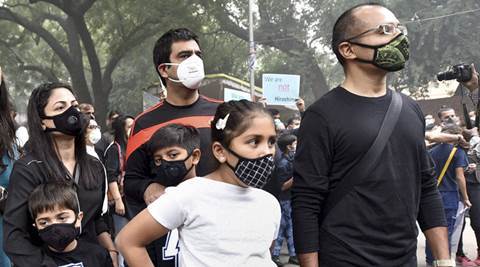We know when food is dirty or water is impure, and take every precaution before consuming them. But when it comes to air, we do not realize how polluted it is because we cannot see it. And we breathe in almost 3000 gallons of air every day!
Between Septembers to February, north India turns into a gas chamber – literally. As parents, we worry about the well-being of our kids. And respiratory well-being is a crucial part of it. In India, we are consistently exposed to high levels of PM2.5. Using masks, installing air purifiers and monitoring the air we breathe are some of the steps we can take to breathe well. In addition, here are some frequently asked questions regarding respiratory wellness.
Can air quality indoors be as bad as outdoor? How can I keep the indoor air quality at home good?
Indoor air quality can often be as bad, sometimes worse than outdoors. Cooking, smoking indoors, burning incense sticks, room fresheners, sprays, deos, even volatile chemicals from fragrances used in conventional cleaners – all these contribute to the particulate matter found in homes.
Use exhausts and chimneys while cooking, avoid incense sticks and vaporizers, check the chemicals in your room fresheners and detergents, vacuum regularly to reduce dust, mites, mold, pet dander, avoid air-drying clothes indoors or keeping floral plants inside the house. Most importantly, make your home a no-smoking zone.
Are there are any particular chemicals one should watch out for while buying cleaning products?
There are certain classes of substances one should check before buying cleaning products. Conventional laundry detergents, fabric softeners, dryer sheets, and air fresheners in solid, spray, and oil form emit volatile organic compounds (VOC’s). Dyes, detergents, paint solvents, plastics, pesticides, adhesives, lubricants, dry cleaning agents release benzene, which contributes to indoor PM2.5. Also look for quaternary ammonium compounds (QACs), especially Quaternium-15 which releases formaldehyde – a known carcinogen. Formaldehyde is also found in glues, environmental tobacco smoke, and in the pressed wood used in furniture.
WHO provides a list of commonly used chemicals in detergents, dyes and paints in its guidelines for indoor air quality, which can be found here.
What are the things that I should look for while buying an air purifier? Does room size play a role?
Given the high PM2.5 concentrations in India, it is essential to buy a purifier with a HEPA filter which protects you against very small PM2.5 particles. You also need a pre-filter which catches the bigger particles preventing the HEPA from getting clogged quickly. Additional levels of filtration are nice to have.
The Association of Home Appliance Manufacturers (AHAM) developed the CADR, otherwise known as the “Clean Air Delivery Rate”. Based on our study, CADR is the best metric to determine the effectiveness of a purifier. If you are trying to pick between a few purifiers of the same cost, go with the one with the higher CADR.
The effectiveness of a purifier depends on the size of the room and the leakage in the room. For rooms with greater size or high leakage, you will need purifier with higher CADR or multiple purifiers. The best way to determine effectiveness is to measure levels in the room with an air quality monitor after the purifier has been running for at least 30 minutes. Also, note that the specified CADR is always based on purifier running at highest speed.
AHAM recommends that filters should be used in rooms whose volumes, expressed in cubic feet are equal or smaller than the filter’s CADR rating multiplied by 12. Assuming height of the room to be 8ft:
- For an 818 sq ft room, CADR should be at least 545 (818*8/12).
- For a 680 sq ft room, CADR should be at least 453(680*8/12).
- For a 450 sq ft room, CADR should be at least 300(450*8/12).
- For a 200 sq ft room, CADR should be at least 134(200*8/12).
Air quality will definitely be cleaner near the purifier – so place it near where you are. You can find more details on air purifiers in this study conducted by Airveda.
Do air purifying plants really help?
As per a NASA study, plants absorb some types of PM along with carbon dioxide. They provide a settling mechanism for molds and dust. Additionally, the microbes in the potting soil also absorb certain compounds. Some plants that grow easily in Indian climate are Areca palm, Money plant, Snake plant and Spider plant.
Do I need a humidifier with an air purifier?
The air in your home should range from 30% to 55% humidity. Delhi winters usually have reasonable humidity so you really don’t need humidifiers or dehumidifiers. However, it is advisable that you check the humidity levels at home to decide on the need for a humidifier.
How can kids’ exposure to bad air quality during school hours be reduced?
Look for schools that are vigilant about air quality and take active steps to maintain good air quality. American Embassy, British School, Pathways, Suncity, Scottish High, Shiv Nadar, Vega Schools are some schools in Gurgaon that have air purifying systems installed. As parents, we can also take active steps, via PTA’s, to enforce air quality monitoring in our children’s schools.
How much do firecrackers really contribute to pollution?
Airveda conducted a study in 2016 where we compared PM2.5 and AQI numbers before and after Diwali.
We found that on Diwali, especially at 2 am on Diwali, the numbers recorded were shocking. The PM2.5 values rose to above 700, while the AQI touched 500 in parts of Delhi, which is the top of the range. Due to atmospheric inversion that happens in cold weather, Diwali firecrackers have a longer lasting effect that continues through winters. This is the reason that at Airveda, we urge everyone to celebrate a cracker-free Diwali.
This is article has been contributed by Namita Gupta , Founder- Airveda







Touche. Sound arguments. Keep up the amazing effort.
I blog often and I really thank you for your content. Your article has really peaked my interest. I’m going to bookmark your website and keep checking for new information about once a week. I subscribed to your RSS feed too.